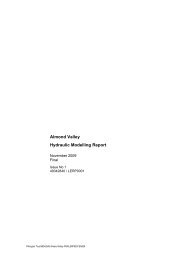Landscape architecture - Directorate for Planning and ...
Landscape architecture - Directorate for Planning and ...
Landscape architecture - Directorate for Planning and ...
Create successful ePaper yourself
Turn your PDF publications into a flip-book with our unique Google optimized e-Paper software.
Position statement<br />
Page 5<br />
At town/city scale<br />
— city parks<br />
— green networks<br />
— <strong>for</strong>est parks<br />
— lakes<br />
— rights of way<br />
At city-region/regional scale<br />
— regional parks<br />
— rivers <strong>and</strong> floodplains<br />
— long distance trails<br />
— reservoirs<br />
Effective adaptation to climate change can be facilitated by green infrastructure<br />
approaches to planning <strong>and</strong> design. Green spaces <strong>and</strong> corridors help to cool our<br />
urban environments, improve air quality <strong>and</strong> ameliorate surface run-off. A green<br />
infrastructure planning approach will reduce flood risk, protect building integrity <strong>and</strong><br />
improve human health <strong>and</strong> com<strong>for</strong>t in the face of more intense rainfall <strong>and</strong> higher<br />
temperatures. Well-connected green infrastructure also provides wildlife corridors <strong>for</strong><br />
species migration in the face of climate change as well as wider benefits <strong>for</strong> recreation,<br />
community development, biodiversity, food provision <strong>and</strong> place shaping.<br />
4.4 Green roofs<br />
Green roofs, roofs which are covered with vegetation <strong>and</strong> soil, can reduce run-off <strong>and</strong><br />
subsequently relieve the pressure on drainage systems, particularly at times of high<br />
intensity rainfall. Additionally, the benefits af<strong>for</strong>ded to biodiversity can be significant<br />
by providing wildlife habitats, particularly in urban areas. They also enhance the<br />
thermal per<strong>for</strong>mance of buildings <strong>and</strong> have an important role to play in reducing the<br />
urban heat isl<strong>and</strong> effect. Green roofs also have the potential to contribute to wider<br />
l<strong>and</strong>scape character in a particular location.<br />
4.5 Sustainable urban drainage systems (SUDs)<br />
Sustainable urban drainage systems (SUDs) reduce the negative impacts of<br />
development on surface water drainage. SUDS can minimise the risk of flooding<br />
<strong>and</strong> pollution via attenuation <strong>and</strong> storage with additional benefits including<br />
improvements to local environmental quality, the creation of habitats <strong>for</strong> biodiversity<br />
<strong>and</strong> general improvement to the quality of life <strong>for</strong> local communities.<br />
4.6 Managed coastal realignment<br />
Sea level rise poses significant challenges to the management of flood risk. Coastal<br />
managed realignment schemes can alleviate some of this risk whilst providing habitat<br />
creation as well as a range of other multiple benefits <strong>for</strong> local environments <strong>and</strong><br />
communities.<br />
4.7 Plant species selection<br />
<strong>L<strong>and</strong>scape</strong> architects underst<strong>and</strong> what species to plant, where to plant them <strong>and</strong> the<br />
conditions different species require in order to thrive. This knowledge is invaluable in<br />
the face of changing climatic conditions, particularly arising from the impacts on the<br />
quality <strong>and</strong> availability of water <strong>and</strong> the potential increase in pests <strong>and</strong> disease.<br />
4.8 Water<br />
Incorporating grey water (domestic waste water) recycling systems into the<br />
design process can assist in adapting to hotter drier summers when pressure on<br />
conventional supplies is likely to be greatest. Grey water can be used in place of these<br />
conventional supplies in, <strong>for</strong> example, irrigation <strong>and</strong> toilet systems.<br />
4.9 The early involvement of l<strong>and</strong>scape architects in a coordinating capacity is essential to<br />
ensure that these approaches are effectively implemented <strong>and</strong> adequately respond to<br />
the challenge of climate change.<br />
<strong>L<strong>and</strong>scape</strong> Institute<br />
<strong>L<strong>and</strong>scape</strong> <strong>architecture</strong> <strong>and</strong> the challenge of climate change
















